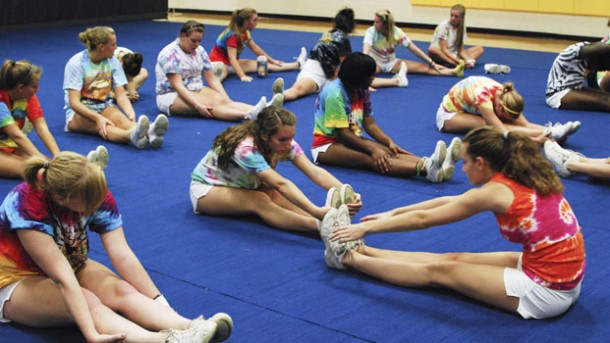As Erik Fabriziani, Head Athletic Trainer at JC, treats yet another student athlete with a pulled hamstring, he shakes his head in disbelief. Don’t students know how to properly stretch these days?
However, a growing amount of research suggests that stretching, although helpful, may not prevent athletic injuries. This has caused much disagreement among coaches and athletes.
Centers for Disease Control and Prevention recently executed a study to determine how useful stretching is for athletes. Stephen B. Thacker, M.D., concluded that more injuries can be prevented by better warm-ups, strength training, and balance exercises, rather than standing around and stretching for long periods of time.
According to Fabriziani there are two main types of stretching: static stretching and dynamic stretching. A static stretch consists of stretching a muscle to its farthest point and holding that position while standing still. A dynamic stretch consists of controlled movement that takes your body to the limit of its range of motion (such as a light jog or walking lunges).
Every sports team at JC warms up and prepares for games and workouts differently. Some teams focus only on static stretching, some focus only on dynamic, while others work both types into their workouts.
The varsity field hockey team performs a mixture of dynamic and static stretches into their warm-ups, therefore raising their heartbeats and loosening their muscles.
Senior varsity volleyball player Casey Knell said that the volleyball team doesn’t bother to incorporate static stretching into their warm-ups. “If you do static stretching and your muscles are still cold, you could do more damage. It wouldn’t be effective if you just did static stretching without doing dynamics to get yourself warm.”
Some people, like father-son duo Jim and Phil Wharton (members of the Stretching for Runners Team) even go as far to believe that static stretching can actually weaken the muscle-tendon connection.
Ross Tucker, a physiologist in South Africa and co-author of the Web Site The Science of Sport, agreed with the Whartons in a recent New York Times study. “There is a very important neurological effect of stretching,” said Tucker. “There is a reflex that prevents the muscle from being stretched too much.” Other studies, like the new track and field association, reports that static stretching does not have many benefits in terms of injury prevention, particularly against the overuse injuries common in running.
Fabriziani said this is not true. As long as the muscles are first warmed up by dynamic stretches, static stretching cannot weaken them. “If you stretch the muscles so they are warm and loose, you’re less likely to get injured,” said Fabriziani.
However, athletes still have to worry about their flexibility and range of motion. Flexibility has been shown to prevent injuries. Muscle groups with greater ranges of motion are less likely to tear when used actively.
Preforming static stretching after a good dynamic warm up will be the most effective way to help your body become more flexible. This helps your body move the way it’s supposed to.
The most ideal way to warm up, according to Fabriziani, would be to perform a variety of dynamic stretches. This could include jogging, cycling, jumping jacks, or any type of movement that increases your heart rate.
After the dynamic stretching would be the static stretching. These should involve stretching all of the major muscle groups such as your quadriceps, hamstrings, calves, shoulders, back, and hips. Another static stretch Fabriziani recommends is to apply heat to the muscle to literally warm it up.
After the static stretches, you are set to work out. Make sure to perform more static stretches at the end of the work out to keep the muscles loose and prevent soreness later on.
While sports trainers and doctors are talking about the benefits of stretching, why is it that you never see those jacked-up bodybuilder types ever pull out a yoga mat? “Some people don’t know how to do it the right way. They are slightly intimidated by stretching. They aren’t confident, so they don’t do it,” said Fabriziani.
This attitude not only hits the gym junkies but it also relates to the athletes at JC. “There are a lot of times people injure themselves because they don’t take stretching seriously. They take the time to talk and regret it later,” said senior varsity football player Ryan Eilerman.
Stretching loosens the muscles, allows you to have an increased range of motion, reduces the risk of injury, and can increase your level of blood circulation according to the SparkDiet Resource Center. “There is no such thing as a bad stretch, only bad technique,” said Fabriziani.
But the decision is up to the individual. Everybody’s body responds differently, and what warm-up works best is purely objective. The best advice is to listen to your body and to do what feels right.
Leah Polakoff can be reached for comment at lpolakoff@jcpatriot.com.



